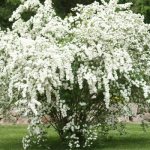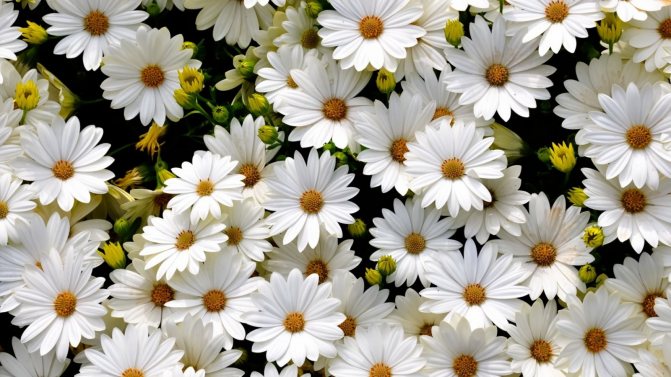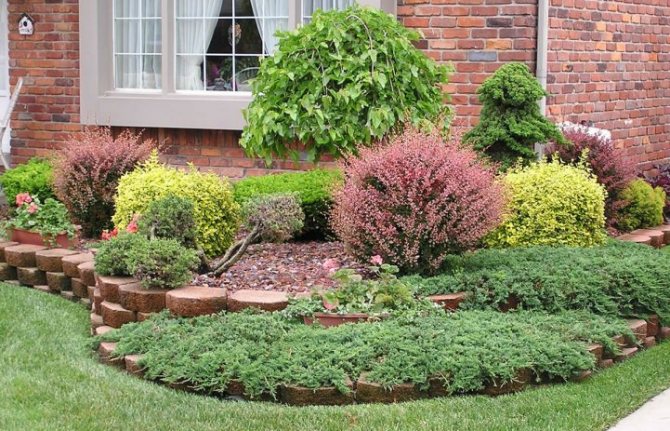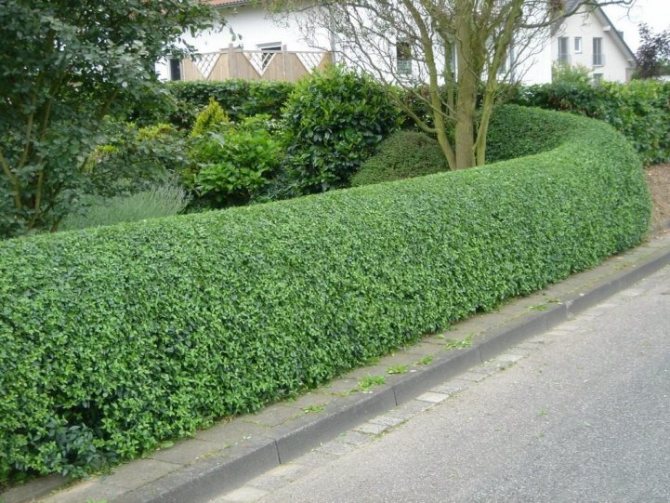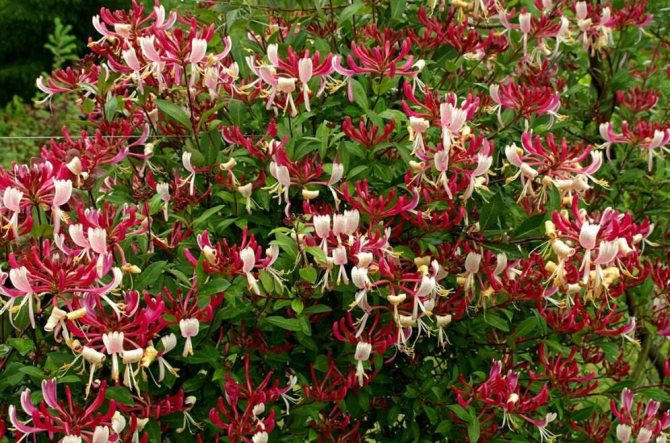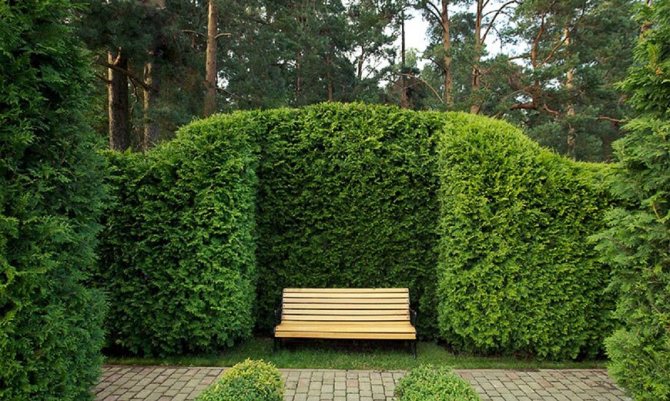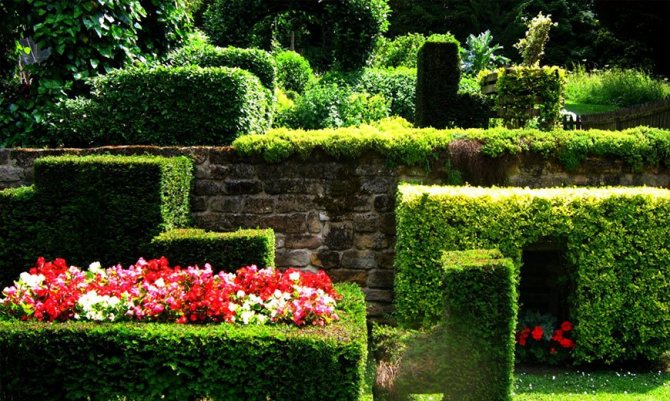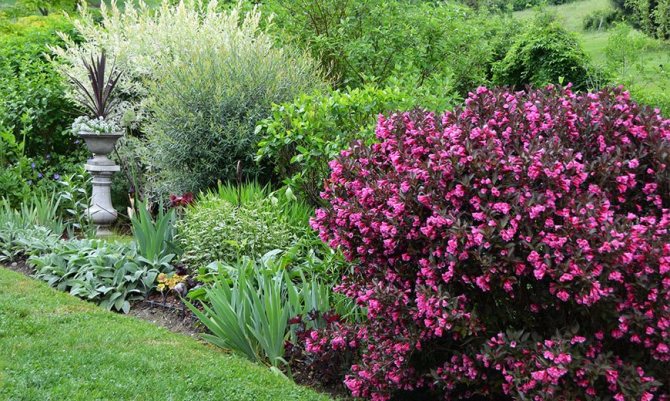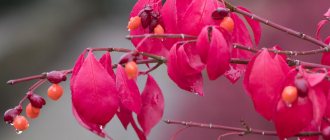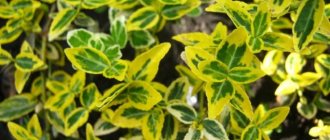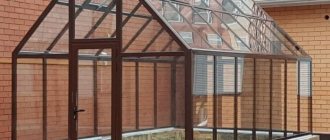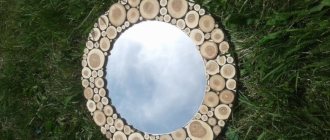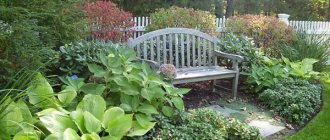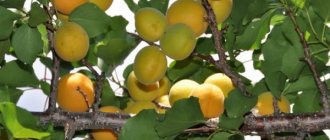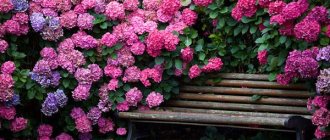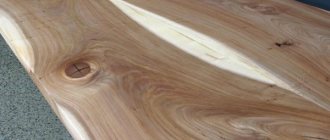An important role in the formation of the landscape of the personal plot is played by a competent combination of plants: annuals, perennials, shrubs and trees with various foliage and beautiful inflorescences. A properly selected assortment of plants will delight the eye from early spring to late autumn.
The topic of today's conversation will be beautifully flowering shrubs, with the help of which you can not only diversify the landscape, divide the territory into zones, but also bring joy and celebration into it.
When planning the planting of shrubs on the site, one should take into account the height and width of an adult plant, so that it does not happen that the undersized specimens will be in the "shadow" of the taller ones, and their beauty will be almost invisible. Although, of course, you can form the crown of plants using garden shears.
Spirea, or meadowsweet
The advantages of the spirea are obvious: it is unpretentious, does not require a special soil composition, and firmly tolerates negative effects in the form of frost, air pollution, heat, wind, and shade. The seedlings grow into mature plants very quickly. And if you consider that this shrub blooms very beautifully, it becomes clear that this is one of the best options for planting on a site as a hedge. But only a low one - a spirea with a height of more than 1.5 m is a rarity.
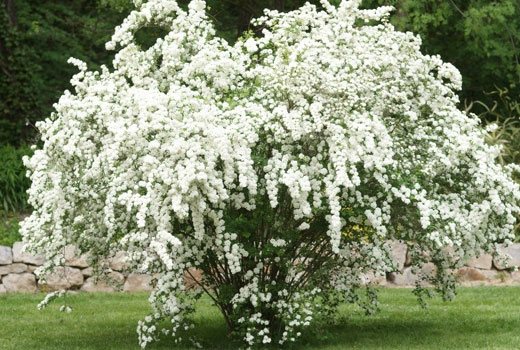
Spirea bushes with drooping branches are good for planting on lawns
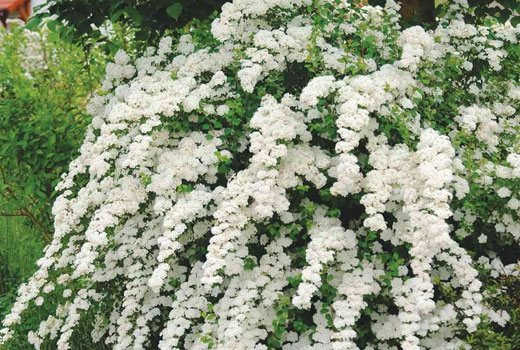

Spirea bushes are strewn with flowers during flowering
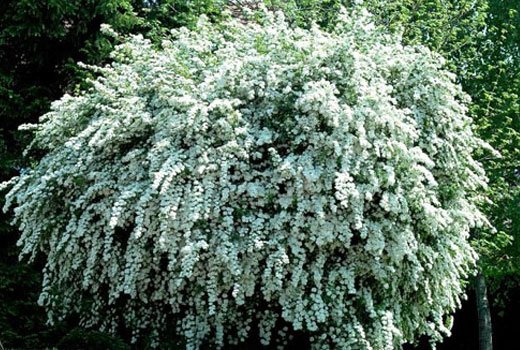

Luxurious spirea
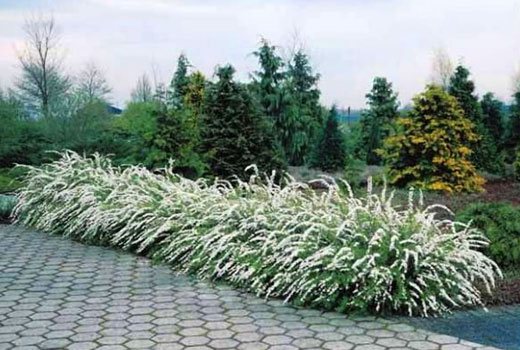

From undersized bushes of spirea, you can arrange a border


Spirea on the lawn
Among the many varieties of spirea, there are shrubs that bloom at different times. If varieties are selected and properly planted, hedges can bloom from spring to late summer. You can focus not on flowering, but on the color of the foliage - red-leaved spireas are very beautiful, as well as those with golden foliage.


Beautiful caps of spirea flowers
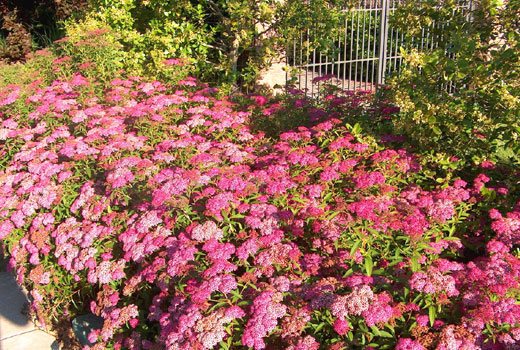

Spirea inflorescences are shaggy and tender


Spirea is a honey plant, surrounded by bees during flowering
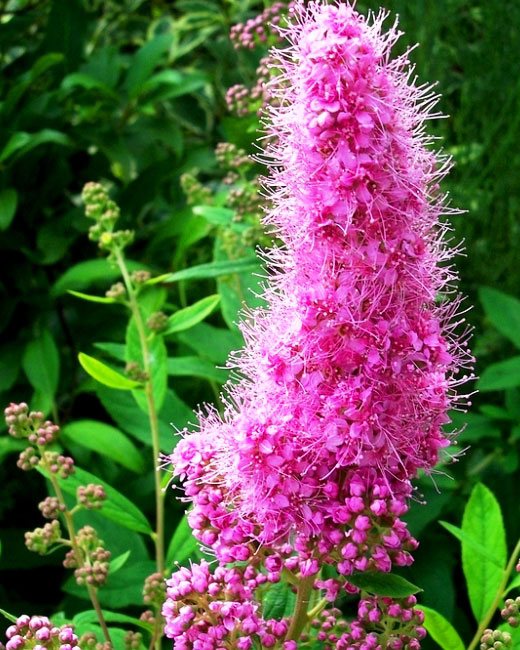

Pointed form of spirea inflorescence
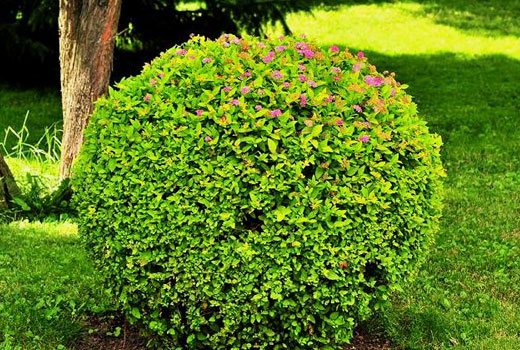

Spirea, formed in the form of a ball
Spirea seedlings are planted in a hedge at a distance of about 50 cm.Immediately before planting, the roots should be pruned - this will improve plant survival and shoot growth. In the planting pits, in addition to garden soil, you can add a little peat and sand (3: 1: 1). Top dressing is desirable in the spring (mainly nitrogen) and at the beginning of budding (more phosphorus and potassium). Reproduction is the simplest - the division of bushes and layering.
Common varieties of spirea:
- Gray
- Arguta
- Wangutta
- Gorodchaty
- Thunberg
- Japanese
- White
- Berezolistnaya
- Billard
- Boomald
Kalina Buldonezh - the eternal bride
If you want to grow a hedge from viburnum, you should pay special attention to the viburnum Buldonezh. According to experts, it is this type of shrub that is best suited for creating green fences. Its main advantage is very beautiful flowering. Unlike the more common types of viburnum, this variety has large, terry balls-inflorescences that do not fade for a relatively long time (about 3 weeks).
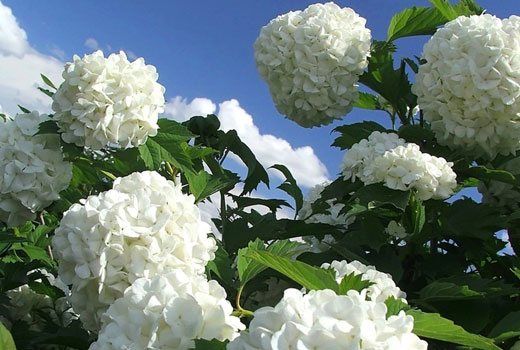

Snow balls Bulldonezh
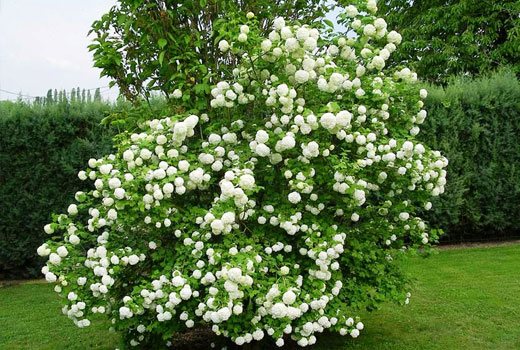

Viburnum bush Buldonezh strewn with inflorescences
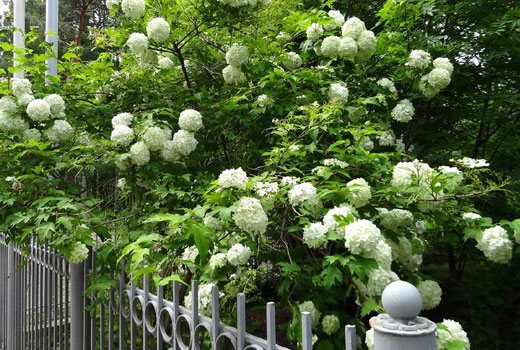

Undersized Bulldonezh in the front garden
True, the viburnum Buldonezh is an ornamental variety, it will not pamper berries. But on the other hand, are they really that important when it comes to hedges? The lack of fruit is fully compensated by the unpretentiousness of the plant and its excellent appearance.


Snow-white inflorescences against a background of greenery


The height of the bushes can be adjusted by pruning
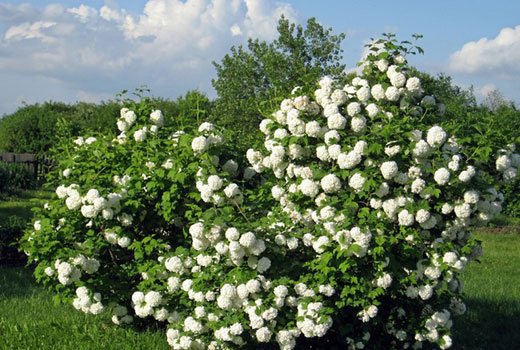

A group of decorative viburnum bushes - volumetric composition
Kalina is planted after 1.5-2 m in one row - this will be quite enough to get a hedge that is quite decent in size. The shrub propagates with the help of cuttings, seeds, layering or dividing the bush into parts.
Viburnum varieties Buldonezh for the garden
- Buldenezh ordinary
- Decorative bulldonezh
- Bulldonezh roseum
Lilac - a child of the sun and rainbow
Lilac is a beautiful shrub of suitable "growth", so many want to see it in hedges. But not all types of lilacs are good in this regard. For example, varietal lilacs, growing up, very quickly become bare from below, moreover, there are many non-frost-resistant among them. And for sure: a lilac hedge should not be made by someone who is not going to constantly care for it.
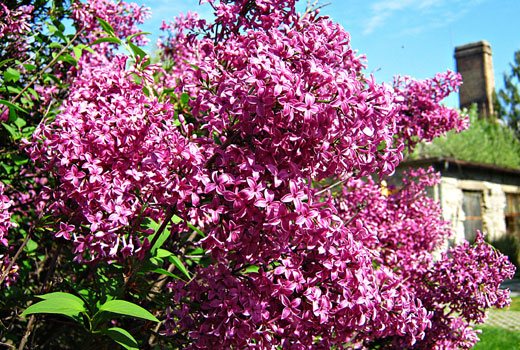

Huge brushes of lilacs are impressive
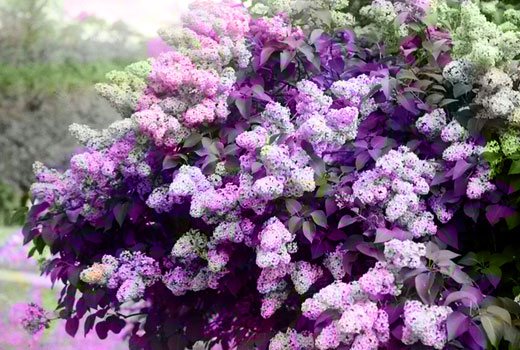

Lush flowering shrub
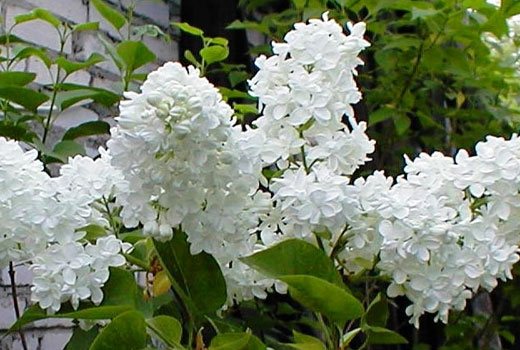

The white flowers of the bush are especially delicate and romantic.
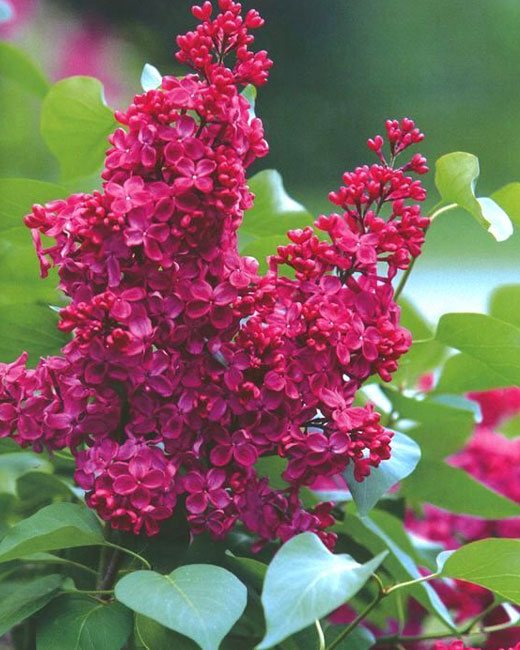

The beauty of Moscow - lilac, beloved by many
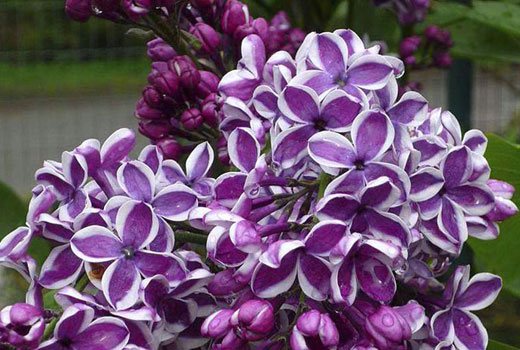

Flower petals with light edging
If, nevertheless, you decide, choose Amur or Hungarian lilacs for planting - they are unpretentious, do not grow too high, they can put up with the increased humidity of the site, they will survive in dry times with minimal watering or even without it. Also, for hedges, experts recommend Meyer's compact lilac (1.5 m height), as well as Chinese lilac, which is characterized by rapid growth.
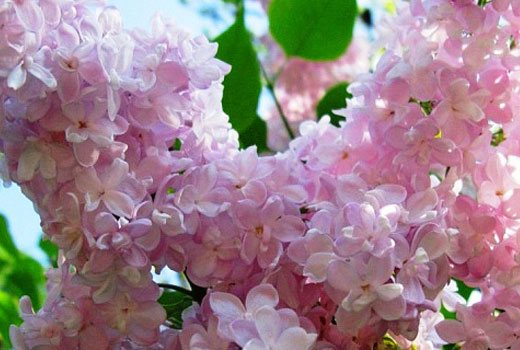

Delicate pink inflorescences make the shrub especially elegant


Lilac brushes are full and numerous
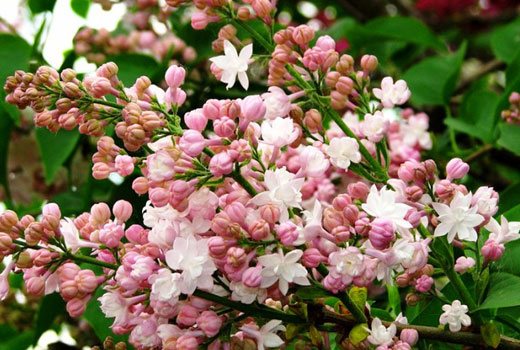

Interesting color of flowers
The minimum requirements that lilacs place on the place of growth: good illumination (otherwise abundant flowering cannot be expected), sufficient air circulation, fertile and loose soil (sandy, clayey, acidic soils are excluded).
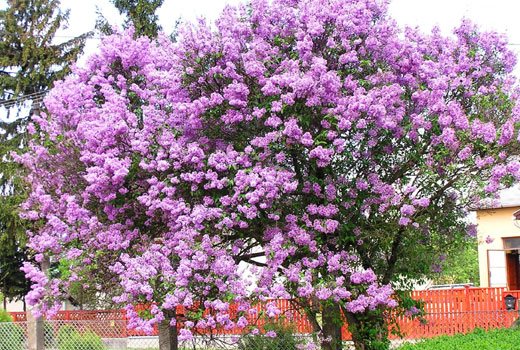

The plant can be formed by a tree
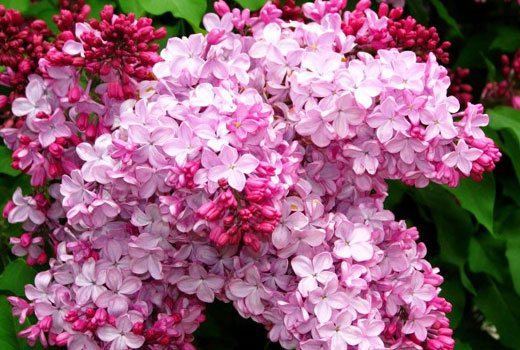

Hot pink flower brushes
Lilac seedlings in the hedge are planted with a step of 1.5-2 m. Annual pruning - immediately after flowering, because the faded plant very quickly begins to lay buds for next year's flowering.
Favorite varieties of lilac
- Beauty of Moscow
- Hungarian
- Flora
- Poltava
- Dream
- Partisan
- Dusk
- Princess Clementine
- Taras Bulba
- A great victory
- Romance
- White Night
- Captain Gastello
- Mulatto
- Alexey Maresyev
Fir
Fir is a coniferous evergreen plant with a grayish, pleasant bark and soft needles. Its roots go deep into the ground, the cones do not fall off, but open right on the tree. Among the decorative and popular varieties:
- Arizona - reaches 7-8 meters in height, has bright red cones, bluish needles, creamy bark;
- balsamic - the smallest of the varieties grows hardly up to half a meter, has a smooth brown bark, rich green needles with a white stripe and purple cones;
- monochromatic - grayish bark, bluish-green needles, tips twisted up, height up to 8 meters.
Fir loves lighted areas and moist, loose soil, therefore, in dry times, it requires watering. It does not tolerate severe frosts, in the first year the roots need a warm layer of spruce branches, which will cover them.
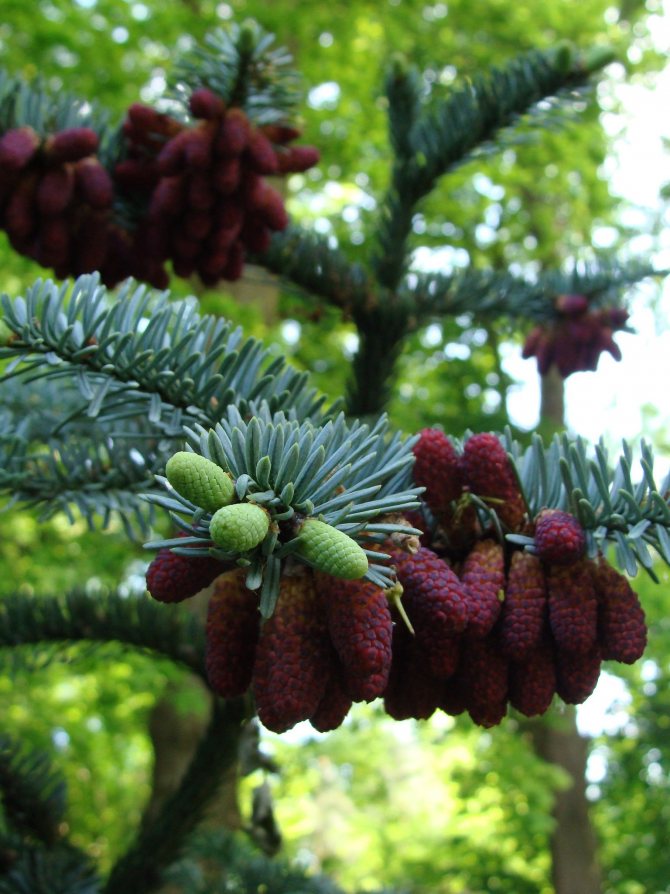

Jasmine (chubushnik) - moonlight of love
The luxurious flowering of jasmine, its aroma, rapid growth, unpretentiousness, the ability to grow on almost any soil, made this plant incredibly popular for our gardens.From its bushes, an excellent hedge is obtained: dense from bottom to top thanks to the many branching shoots, decorative from spring to autumn.
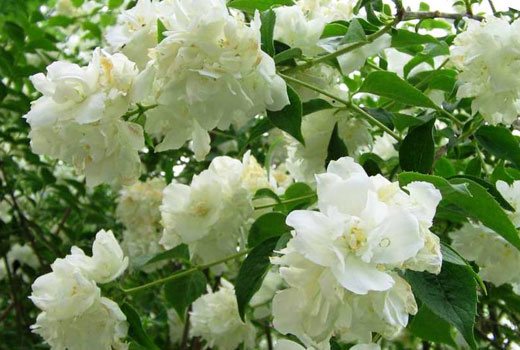

Double jasmine flowers
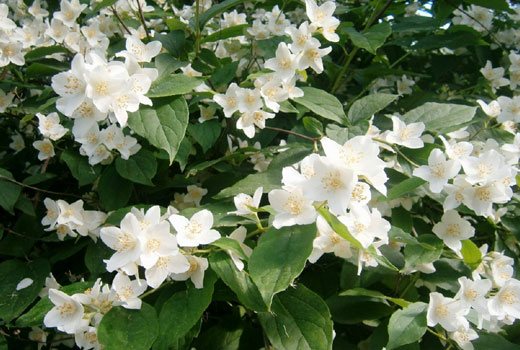

Jasmine - simple-flowered mock-orange is also charming


Graceful shrub flowers attract insects with a sweet scent
If the place is well lit by the sun, and the soil is not waterlogged and fertile enough, the mock-orange blooms profusely annually. Flowers appear already on annual plants, young shoots on adult plants are covered with flowers the next year.
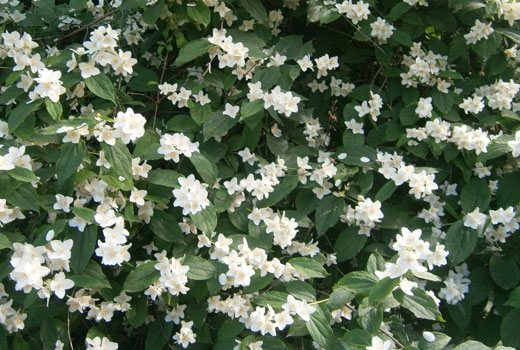

The bush is strewn with white flowers
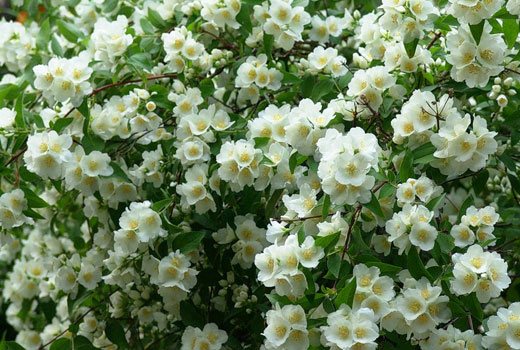

The flowers make it difficult to see the leaves
In a hedge, seedlings are planted at a distance of 0.5-0.7 m. Usually, they take root well - the root system is strong. It is not difficult to propagate a chubushnik by dividing the bush or by green cuttings (during the flowering period of the plant). Recommended varieties of garden jasmine
- Avalanche
- snow avalanche
- Elbrus
- Mont Blanc
- Komsomolets
- Kazbek
- Arctic
- Flight of moths
- Pompon
- Moonlight
- Virginal
Forsythia - golden lilac
Many gardeners consider forsythia one of the most successful hedge solutions. This dense, beautiful shrub grows quickly and does not require much attention. A feature of forsythia is early flowering. The bushes are covered with bright yellow flowers even before green leaves begin to appear on the rest of the plants in the garden.
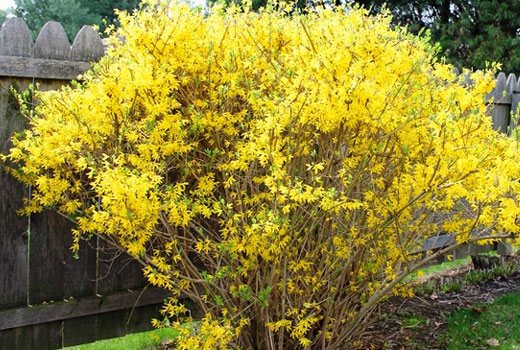

the shrub is like the sun: it seems to emit light


Pruning regularly will keep the bushes neat
Forsythia is planted in the fall, before the onset of frost. It should be borne in mind that the shrub grows strongly over time and can reach a height of about 3 m, and up to 2 in width. When planting, the optimal distance between individual bushes is 1-1.2 m. When the bushes grow, they form a dense, solid "wall".
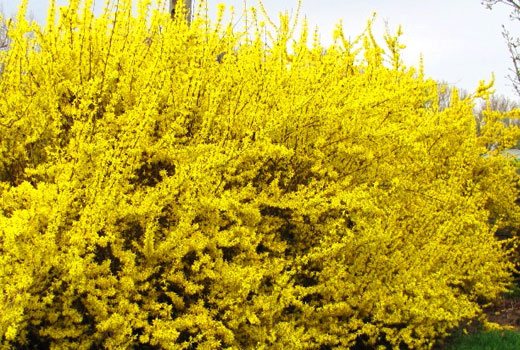

In early spring, when flowers are so lacking
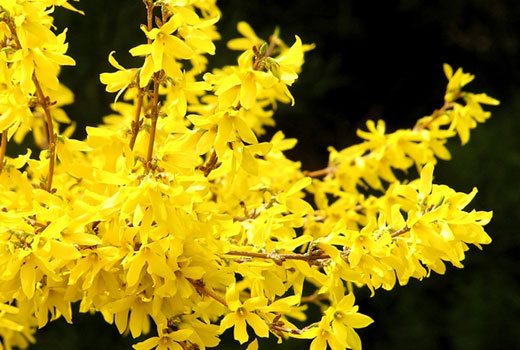

Sunny shrub in the garden - to joy
Another important feature of growing forsythia is its intolerance to excessive soil moisture. To ensure good water permeability, the soil must be loose. Drainage is poured at the bottom of the pits or trenches, where the plants will subsequently be planted. Moreover, the drainage layer should be made quite large - up to 20 cm. A layer of river or construction sand is poured over it.
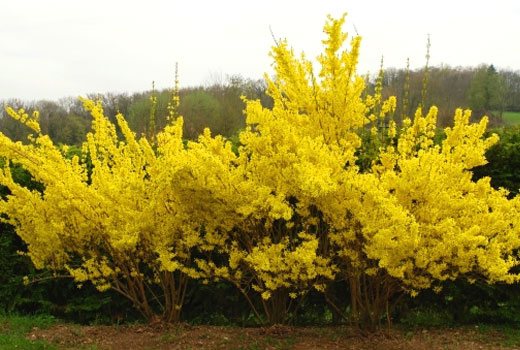

In the hedge, forsythia is in place
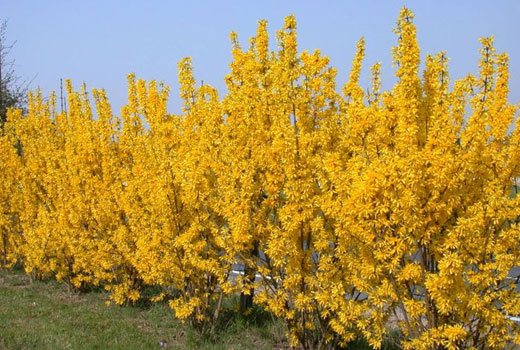

The shrub loves sun-drenched outdoor areas
Forsythia likes alkaline or neutral soils. It is recommended to neutralize the acidity of the soil by adding a small amount of wood ash or lime directly to the planting hole for each bush.
The easiest way to propagate plants is by layering, bending the lower shoots of the bush to the ground, or by green cuttings in late May-early June.
The best varieties of forsythia
- Variegata
- Spring Glory
- Fortune
- Siebold
- Denziflora
- Tetragold
Weigela - chameleon bush
Weigela bushes are lush, 1-1.5 m high (rarely more). Although there are dwarf forms of plants that grow no more than 0.5 m in height. One of the interesting features of this ornamental shrub is its double flowering. The first time weigela blooms in early summer, the second - in September. Moreover, flowering lasts a long time - 15-30 days. The plant loves freedom, therefore, a dense fence cannot be formed with their help, but a free-growing separating "tape" from it is a miracle.
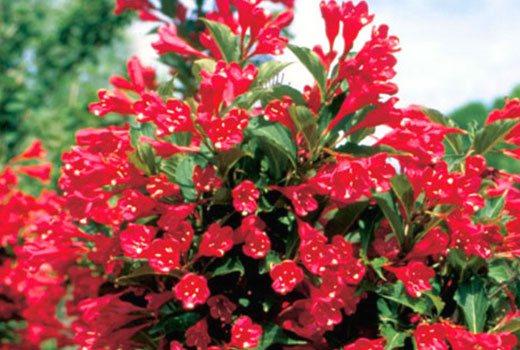

Weigela varieties Florida with red flowers


This plant always attracts attention with its decorative effect.
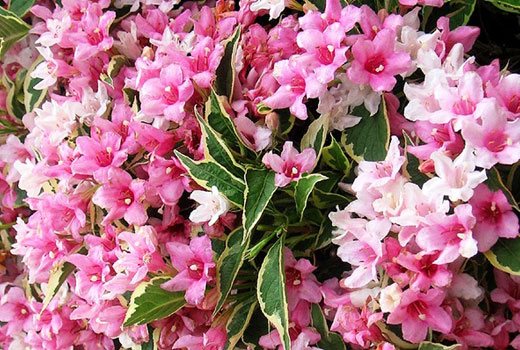

Pink flowers shrub
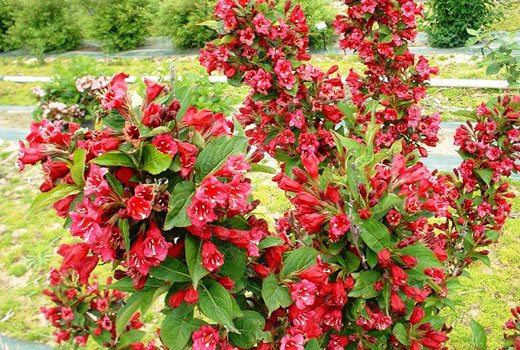

Flowers bells are large and cover the branches almost completely
Weigela prefers areas well lit by the sun or partial shade. You cannot plant this plant in an area with thick shade - it will develop slowly, the bushes will become stunted and weak.If there is an artificial or natural fence nearby that prevents the sun's rays, it is better to choose another shrub for the hedge.
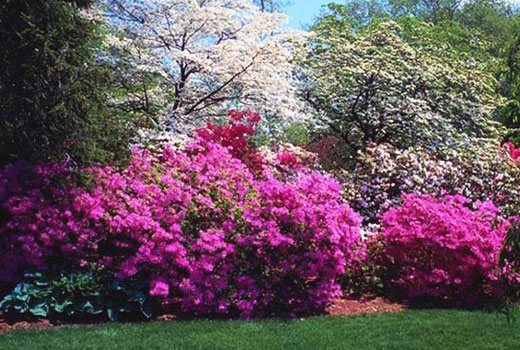

Several bushes of a plant planted in a row - splendor
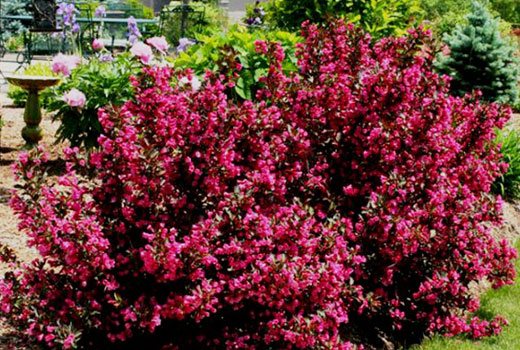

Dark red flowers look original


Weigela hedge is not high, but very elegant
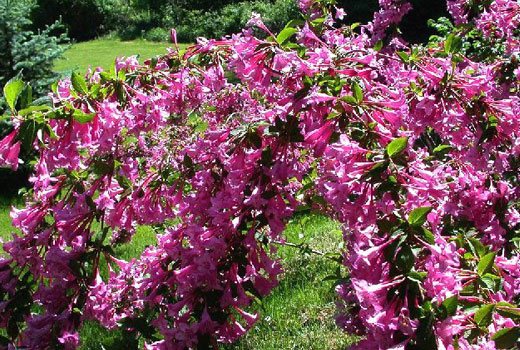

The long branches of the bush are picturesque
It is customary to plant weigela in the spring. To do this, choose healthy seedlings up to 3 years old. The distance between individual bushes is made quite large (1.2-1.5 m), since the weigela grows widely. If the moment for planting was missed in the spring, you should not try to plant a hedge in the fall. At this time of the year, the plant does not take root well, and most of the seedlings may simply die.
Weigela loves fertile and, at the same time, well-loosened soils. It is optimal to lay a mixture of turf, humus and leafy soil (in equal proportions) in a planting hole. And since the shrub does not tolerate excess moisture, it is recommended to lay a drainage layer at the bottom of each planting hole.
Weigela varieties for the gardens of our climate
- Purpurea
- Early
- Korean
- Hybrid
- Eva Rathke
- Rosea
- Middendorf
Ivy
Ivy refers to liana-like climbing shrubs. It can reach a height of 30 m. Ivy foliage is large, about 25 cm in length, it can have a green, yellow, brownish color. In autumn, the plant blooms with yellow-green umbellate small inflorescences. The next spring, after planting on ivy, black berries form.
Did you know? When rubbed, ivy leaves give off a nutmeg smell. Due to this property, they are used in cooking as a spice or decoration.
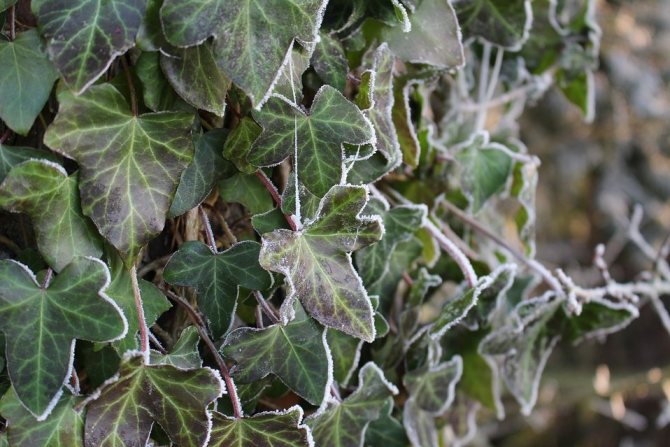

Ivy grows for a long time and looks very impressive at the same time. With the help of supports and a garter from it, you can form beautiful cascades hanging from parkans, fences, balconies, a living evergreen gazebo or even a canopy. The plant tolerates shading well, but develops best in illuminated areas. Loves warmth and fertile soil. Ivy is propagated, most often by cuttings.
There are a large number of decorative forms of ivy, and the most popular are:
- winter - stands out with very large, wide, light green foliage;
- Baltic - the most frost-resistant variety, has small leaves of rich green color;
- treelike - is a small upright shrub with beautiful green leaves with silvery spots;
- tricolor - in autumn, the leaves at the edges acquire a charming bright red color;
- bordered - it is distinguished by the fact that the foliage at the edges is framed by a yellow stripe, which in the fall changes color to red or pink.
Ivy loves moist, loose, slightly acidic soil, but it is especially undemanding to the composition of the soil. It is recommended to mix the top layer of earth with which the root of the plant will be sprinkled with sawdust and peat.
Japanese quince (henomeles) - fire bush
Japanese quince is a medium-sized shrub that can reach 1-1.2 m in width and height. Leaves are green and shiny, may have an original color with a bronze tint. The flowers are red, crimson, pink, up to 3-5 cm in diameter. In September, large edible fruits ripen from the flowers, which also look attractive.
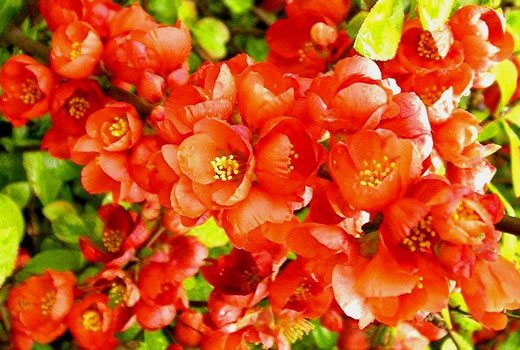

Japanese quince flowers


The shrub grows slowly, but for the sake of such beauty it is worth tolerating
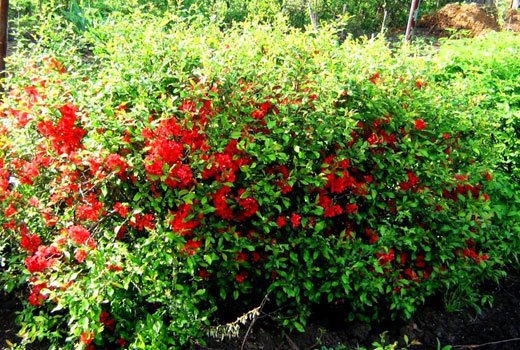

Flowering begins
A feature of Japanese quince is slow growth. Within one year, the growth of a shrub can be only 3-4 cm. Of course, if you create ideal conditions for a plant, then the growth can be more, but not much. But Japanese quince is great for creating beautiful dividing hedges on the site. This plant tolerates any negative environmental influences, shading, and excellent shearing.
It is better to plant Japanese quince in early spring, even before the buds begin to bloom on the trees.If the seedlings were purchased in the fall, planting can be done, but no later than September, each bush must be hilled high when cold weather sets in.
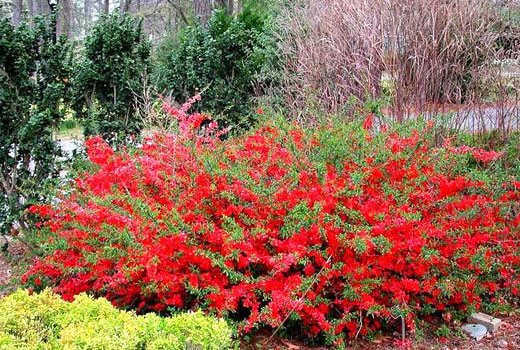

Bright red bloom
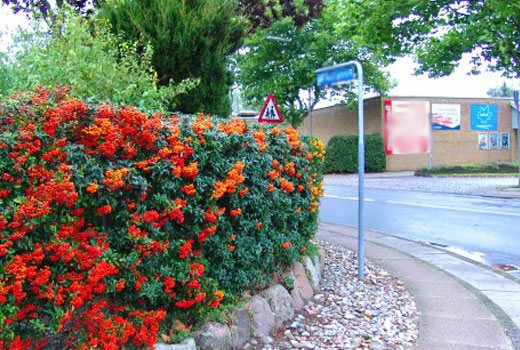

Japanese quince in a hedge
The distance between individual bushes is left not too large, about 0.5 m. As for the depth of the hole, it should be such that the root collar remains above the soil surface.
In severe frosts, Japanese quince shoots can freeze, but the bush is restored quickly. Japanese quince is propagated mainly by seeds. Layers and offspring form roots for a very long time, you can get a plant with their help in a few years.
The most beautiful varieties of Japanese quince
- Nika
- Nikolay
- Maulei
- Citrine
- Diamond
- Merlozi
- Simoni
- Holland
- The Snow Queen
They are not afraid of winter threats ... Evergreen herbaceous plants in the garden
And the leaves of coniferous plants, living on average from two to twenty years, may not necessarily be green, but yellow and even red in different shades.
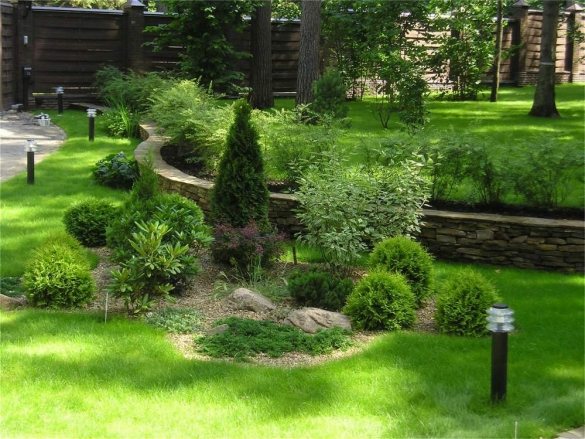

There are not so many evergreen plants suitable for growing in personal plots. Moreover, not all of them are decorative all year round. Southern evergreens do not tolerate our northern winters well - they die in severe frosts. Strong, gusty winds and other unfavorable conditions can also lead to their death. On some evergreens, the leaves do not look the best in winter, but nevertheless, many such popular trees and shrubs enliven our winter gardens with their colors, change their appearance, clearly standing out against the background of bare deciduous trees.
Some plants, such as St. John's wort and viburnum, are grown for their showy flowers. Others create a decorative effect with both their foliage and inflorescences, such as rhododendrons and bergenia. Among evergreens, there are such plants that are grown exclusively for the sake of easily tolerating cold leaves.
For any climatic conditions, for any garden, there are suitable evergreen crops, various in size, color and crown shape.
This article is devoted to those evergreens that are suitable for growing in small garden plots in the Leningrad region.
Low shrubs, dwarf shrubs and ground cover plants play an important role in garden design: they grow rapidly, covering empty areas of land with a green carpet.
Tall plants, mainly conifers, are widely used to create hedges. Low conifers are planted in flower beds and in various borders. Evergreens are also often planted on lawns and in containers.
Do not overdo it with the number of evergreens in the garden, otherwise it will look gloomy and boring. They can play a dominant role and, in combination with deciduous crops and bright colors, create unique contrasts. Designers recommend maintaining a balance between evergreens and deciduous plants in the garden.
The most popular are evergreen ornamental shrubs with beautiful flowers (rhododendron, heathers, mahonia, viburnum and others). A number of evergreen shrubs are grown exclusively for their leaves. Evergreen herbaceous perennials are spectacular, such as carnation, bergenia, purse, thyme, and clefthoof.
When choosing plants for your garden, remember that:
- you should purchase seedlings zoned for the conditions of the location of your site;
- it is better to purchase the most popular varieties tested by your friends;
- some plants that winter well in the southern regions of the Leningrad Region do not tolerate frosts on the Karelian Isthmus, they should be insulated.
- when choosing a place and purpose of planting - a flower bed, a curb, a mixborder, a green hedge, an unpaved carpet, etc.- both the height of the plant in adulthood and its shape, color, growth rate must be taken into account. It is also necessary to make sure that the selected specimen is suitable for the given place, soil acidity, drainage, lighting. Do not forget to set the water table - this is especially important for evergreen trees and shrubs, especially conifers.
- you should buy an evergreen plant only in a container or with a lump of earth, because even a short-term drying out of the roots can lead to the shedding of leaves, after which the plants are difficult to recover. In addition, landing in containers is possible without any time limit.
Let's dwell on the most popular evergreens in our region.
Azarum (clefthoof)
The leaves of azarum are similar in shape to the leaves of cyclamens - they have a heart-shaped or hoof-shaped shape, which is why our plant is called a hoof.
Of the popular types, Eastern, Siebold and Canadian can be distinguished. Some have glossy leaves, others have an exquisite texture, and some have a striking silvery color. They also differ in the size of the leaves.
Azarum loves organic-rich, slightly acidic, moist, drained soil, so it should be planted in moist, shady places. This deciduous ornamental plant looks great in the borders of flower beds and in group plantings. The Clefthoof is popular for its beautiful leaves, winter hardiness and hardiness. It densely covers the ground with a green carpet, forming ground cover clumps of various densities, which restrain the growth of weeds.
Overwintered clefthoof leaves grow old and fall, however, having lost them, the plant hastily acquires very tender new ones.
Thrift
Armeria forms a cushion of grass-like leaves, above which in the spring, bouquets of bright pink, red and white small flowers rise on thin peduncles. Re-flowering in autumn is possible. There are many varieties of armeria, and they are quite affordable.
Badan
It is a spectacular groundcover with large, fleshy leaves up to 30 cm in diameter, which grows rapidly to carpe over open areas. At the end of autumn, with the onset of winter cold weather, oval-heart-shaped blunt-toothed leaves of badan acquire a beautiful lilac-red or bronze hue.
Overwintered leaves turn black, and new ones grow to replace them. On fleshy peduncles, medium-sized bell flowers of lavender-pink, pinkish-purple or white flowers with a waxy bloom appear. The flowers are collected in dense paniculate-scutellous inflorescences ranging in size from 8 to 18 cm. In one inflorescence, there are up to 130 flowers. The duration of blooming of badan is from late April - early May to late June, unless it falls under spring frosts. Secondary flowering is possible in August or September.
The best place for badan is semi-shady. It grows well in the sun. This plant prefers neutral or slightly alkaline, loose, nutritious, well-drained soil in elevated areas, with constant moisture. Badan is drought-resistant. In spring frosts, it should be insulated so that the flower buds do not freeze. Badan propagates by seeds and division of overgrown bushes. Seeds are sown in early spring.
You can use this plant in compositions in flower beds, ridges, alpine slides, rocky gardens.
Periwinkle
Rhizome shrub with recumbent or ascending stems and evergreen wintering leaves. In spring, graceful single five-petal flowers with a diameter of 2 to 5 cm, simple or double, appear on short, upright shoots 15-20 cm high. Flowers, depending on the variety and growing conditions, differ in number, size, and color: they are pale blue, lilac-blue, dark blue, blue with a purple tint, lilac or white.Elliptical leaves with short petioles, leathery and shiny, also differ in color: dark green, light green with cream edges, yellow. There are varieties of leaves with a two-color color: golden and silver-motley.
The stems grow 40-60 cm per season and are able to bloom again. The fruit forms two oblong or cylindrical seeds of a brownish or brown color. Roots - numerous and fibrous - appear on all nodes of the stem when they come into contact with the ground.
Periwinkle belongs to very strong plants. The everlasting, dense greenery is used to create a wonderful dirt carpet in shady, semi-shady and sunny locations with good drainage and moist soil. The branches of this plant, expanding, intertwine. Periwinkle is well suited as a groundcover for banks, embankments and other sloping areas. It is also used in ampelous form.
Small berry rugs are effective on rocky slides. It is also used for planting in curbs and curtains between trees.
It is not difficult to care for periwinkle: you can rarely water, and top dressing is optional.
Loose mint
This creeping plant with white and yellow flowers has long been loved by gardeners. It retains foliage all year round, covering the ground in damp, shaded areas. The wild species of this plant grows strongly, but the cultivars are quite compact.
From May to August, numerous yellow flowers up to 2 cm in diameter bloom on the stems.
Verbeinik prefers moist soil and a little shade, but there are varieties that grow excellently in sunny places.
Carnation
One of the most popular and widespread plants. There are up to 300 species of herbaceous one-, two- and perennial carnations. Among the many species, there are evergreen and semi-evergreen forms.
Carnations have a simple, branched and erect stem. Leaves are sessile, linear, linear-lanceolate, flat or slightly grooved. The leaves are green, reddish or bluish in color. Flowers are solitary, collected in brushes or panicles; pink, lilac, white, red or yellow.
With their lavish flowers, delightful carved petals and the almost always pleasant scent of carnations, they add charm to the garden. Winter hardiness of many types of carnations allows them to be cultivated in the north. To preserve greenery, it should be covered with spruce branches for the winter - not so much from frost, but from mice. There is no need to cover low varieties, since they retain greenery under a layer of snow without additional cover.
Heuchera
Ground cover plant from the saxifrage family. Possesses luxurious wide rosettes of leaves. The leaves are lobed, oval, heart-shaped, covered with fluff and permeated with veins. Small charming flowers sit on tall peduncles.
Heuchera is grown for its decorative leaves. Flowers - white, pink, red and even green - appear on peduncles 45 to 75 cm high.
Popular varieties are Peter Moon (pink flowers and marbled gray leaves), Red Spendlis (red flowers and pale green leaves with dark green streaks), Greenfinch (green flowers and green leaves).
Heuchera rhizome is short, dense and slightly creeping; the root system is shallow.
Heuchera is easily propagated by sowing seeds, dividing rhizomes and cutting rosettes. Grows well on all garden soils, but prefers loose and fertile soils. It can take a very long time without transplanting, but young 2-3-year-old plants look neater and bloom more abundantly.
Heuchera is hygrophilous, but drought-resistant. It develops well and blooms in partial shade and in the sun. In snowless periods of winter, it requires dry shelter with coniferous spruce branches.
Tenacious
One of the most interesting ornamental ground cover plants. Propagated by aerial creeping shoots, which end in rooting rosettes.Her root system is fibrous, shallow, but strong.
The tenacious bloom in early summer. Inflorescences up to 30 cm long consist of numerous small blue flowers. She is unpretentious. Good for filling all empty and unattractive places under trees, shrubs, and also looks good among colorful plants in flower beds. On nutritious soils, the tenacious forms luxurious carpets.
The leaves, as a rule, are brown-beetroot or dark green; in the bright sun, the color of the leaves becomes more expressive.
Use this plant to create groundcover, curbs, and to anchor slopes.
Iberis (stennik)
In addition to annual and perennial species, winter-green forms are of particular interest. These are overwintering shrubs with small oval-lanceolate stem leaves. The root system of this plant is weakly branched and deep-lying.
Small flowers 2 cm in size are collected in corymbose inflorescences. Growing up, the plants completely cover the planting area, turning into a pillow up to 30 cm high, and flowers rise above the evergreen leaves.
Reproduction in Iberis is seed or vegetative - by layering and cuttings.
Iberis is grown on soils of medium fertility with good drainage, while taking into account the fact that he loves full or partial lighting.
Saxifrage (saxifrage)
In our country, about 90 species of this plant are widespread, but no more than 15 of them are used to decorate the garden. Saxifrage is a plant with a height of 5 to 70 cm, creates thick or loose curtains in the garden.
The leaves have various shapes: from lanceolate to rhombic, color - from green to yellow-spotted. Flowers are five-petal, small, stellate; there are white, yellowish, pink, cherry and greenish. The paniculate inflorescences of this plant are very showy. Saxifrage blooms from May to August. The vast majority of species are evergreen.
Saxifrage easily reproduces vegetatively: by dividing the curtain, cuttings, single rosettes after the plants have faded.
These plants are unpretentious, prefer calcareous soils, sunny location and good drainage.
Plant saxifrage on rocky hills, in shady flower beds, use it to decorate the banks of reservoirs and create separate curtains.
Of the evergreen saxifrage, such species and varieties are widely used as urban (up to 30 cm high), Arends (they are sometimes called "Moss-shaped saxifrage"), opposite-leaved (blooms very profusely with pink-red flowers), shady (creates beautiful dense curtains of flat rosettes about 5 cm in diameter, the leaves are round, almost smooth, green and yellowish-spotted), Elizabeth (with yellow flowers), turfy (forms dense, pillow-like thickets up to 20 cm high; flowers are white and pink-cherry), Pennsylvania ( grows in damp places).
Cat's foot (antennae)
Most species are groundcover, low-growing perennials with small silvery leaves and inflorescences that resemble a cat's footprint. The bush grows up to 25 cm in height and up to 45 cm in diameter. Forms dense silvery carpets of small rosettes located at the ends of creeping branching shoots. In June, small inflorescences appear in a range of colors from white to crimson.
It reproduces mainly by dividing the curtains in early summer or closer to autumn, at the end of August. Regular rejuvenation is required after 2-3 years.
The cat's paw prefers loose, poor soils; drought-resistant and sun-loving, but shade-tolerant. In addition, this plant is winter hardy and does not require shelter.
The cat's foot is used for borders in flower beds, planted between slabs of paths and on dry slopes.
Medunitsa (pulmonaria)
The lungwort is an irreplaceable curb plant and all of its species are extremely interesting.She has bizarre colors: with aging, the color of the corolla of the lungwort changes from pink or purple to purple or blue. The lungwort blooms for a month. Its flowers are bell-shaped or funnel-shaped with a bend, on long cuttings there are delicate pubescent leaves of a heart-ovoid shape, and on the upper side of the leaves there are blurry light spots. In winter, under the snow, there are bunches of basal, highly overgrown rough leaves. The lungwort prefers shady places.
Medicinal, narrow-leaved, sugar, red, Folyarsky's lungwort - various types of this plant are widely used in our country when creating background clumps, contrasting compositions in flower beds, especially in combination with hosts, ferns and other perennials. It is recommended to plant in shady places.
Rejuvenated (sempervivum)
This succulent is a popular garden decoration plant. Spherical rosettes of fleshy leaves ranging in size from 4 to 15 cm have different colors, density and pubescence. In summer, yellow, red or purple star-shaped flowers bloom, collected in spectacular corymbose-paniculate inflorescences on thick peduncles. Non-blooming rosettes live for several years. The rejuvenated forms dense ground cover clumps.
This plant propagates by daughter rosettes growing at the ends of ground stolons. It is unpretentious, tolerates any soil, and is sun-loving and drought-resistant. It is quite frost-hardy, but in severe frosts, the young should still be covered with spruce branches.
The most common types of juveniles are arachnoid, offspring and roofing. All types look good on rocky hills, in the crevices of the walls.
Evergreen spurge
Evergreen euphorbia is one of the many types of euphorbia. The name of the plant is not accidental - there are species with white milky sap that flows from a wounded plant.
Evergreen milkweed leaves are dark, shiny and collected in dense rosettes. The flowers form inflorescences, in the middle - one female flower, around - several reduced male flowers.
Euphorbia is planted in rock gardens and curbs.
Aubrieta
An irreplaceable ground cover plant with dense gray-green pubescent small foliage. In early summer, the leaves are hidden under small flowers of the most varied bright colors. After flowering, pruning is required. Ideal for green carpet, the root system of this plant is shallow. Seed and vegetative reproduction. The main method is division in the spring, at the beginning of growth. Cuttings - in the second half of summer with new shoots that grow back after flowering.
Aubrieta is unpretentious to soils, but prefers well-drained areas, illuminated by the sun. Hardy, but still it should be closed for the winter - in case of severe frosts. Stagnant waters pose a great danger to obriety in spring. Popular varieties are: Forward-looking (up to 12 cm in height), Aurevaregata (lavender flowers and leaves with a gold border), Bressingham Pink (double pink flowers) and Dr. Malis (purple flowers).
Fescue (festuca)
An exquisite plant for an elegant green carpet. Fescue is a decorative cereal with blue foliage. The sizes of the festuka are varied: from small (for a rock garden) to large (for borders, mixborders and specimen plantings). This plant is distinguished by its originality of shape and interesting for its blue color.
The most popular is gray fescue (glauka), which forms bumps of dense gray-blue foliage up to 15 cm high. The Blue (Blue Far) variety has pure blue leaves, while Amethystova has gray-blue leaves, and it forms larger bumps. For rock garden widely used dwarf fescue veliysk, variety Sibirsi.
The soil for fescue is not very fertile, with good drainage, and illuminated by the sun.
Sedum (sedum)
This deciduous succulent is very popular.By type, sedums are divided into erect, ascending, creeping and rooting. The flowers of these beautiful deciduous ornamental plants are stellate, white, yellow and pink, collected in corymbose, paniculate or umbellate inflorescences.
Sedum is unpretentious, frost-resistant. Used to cover soil, rockeries and curbs. In our zone, the following varieties of sedum are most common: Caustic, White, Thick-leaved, Bent, False. But this is not a complete list of existing evergreen stonecrops.
The sedum is caustic, 4-8 cm high, has ascending or recumbent shoots. Leaves, fleshy and short, cover the vegetative shoots. The flowers are golden yellow, up to 1 cm in diameter.
Sedum propagates by seeds and cuttings.
Fern
There are few evergreen species among ferns. One of them is a multi-rower. His vai are collected in a rosette that resembles a shuttlecock. There are dwarf multi-row plants for ground cover plantings and rock gardens, there are large ones for borders and flower beds in wooded gardens. In frosts, the fern can freeze, so the rosettes are covered with peat or other covering material, and in the spring they are opened.
Vai of this fern reach 1.2 meters in length. The leaves of various varieties are strongly or slightly dissected, resembling a feather in shape. Varieties vary in size and leaf shape.
Ferns reproduce in the spring by dividing the bush. It should be remembered that they love the soil fertile, well-drained and prefer partial shade.
Sagebrush
Wormwood is loved by gardeners for its feathery silvery fragrant greenery. Wormwood comes in many shapes and sizes. Among the types of wormwood there are half-shrubs, there are border perennials, wormwood is often used as a ground cover plant for a rock garden. But not all varieties of wormwood are evergreen.
Primroses (primroses)
Of the many species and varieties of primroses in winter, only the ear primrose retains its green leaves. But even among the ear primroses, not everyone can withstand our cold. The most stable border hybrid Aurikula is noted, with fleshy spoon-shaped leaves and fragrant flowers on peduncles 10-20 cm high. Flowering begins in early summer. The flowers of this primrose not only have a pleasant aroma, but also delight with their beauty and richness of color combinations - there are yellow, gray-blue, raspberry-blue, red-brown-yellow.
Successful cultivation requires well-draining soil and partial shade.
Rezuha (arabis)
A charming unpretentious groundcover winter-green plant with many flowers on overwintered shoots. The flowers are simple, double, white and pink. They create luxurious curtains or are used in rockeries.
Rezuha perfectly reproduces by seeds and vegetatively. Periodic rejuvenation is required. After abundant flowering, pruning of faded shoots is necessary - this provokes the regrowth of new ones.
Loose, fertile, drained, non-acidic soil is preferable for razuha. This plant is light-requiring and drought-resistant, but suffers from stagnant waters, and requires shelter in severe frosts.
Rezuha can be used to create decorative groups, curtains, curbs, green "spots" in rocky gardens and to anchor slopes.
Tiarella
An ornamental plant with panicles of white or creamy white frothy flowers. Small and delicate, they are placed on peduncles up to 45 cm high and bloom from mid-spring for four to six weeks, towering above the clumps of beautiful sharp-toothed fluffy leaves. Heart-shaped leaves, moderately green in summer and reddish-bronze or dark purple in autumn, remain until winter. They may have black streaks or spots that give them a peculiar beauty. Growing vigorously, tiarella creates a charming ground carpet up to 30-45 cm high. It is used for planting along the edges of curbs, in rocky gardens or for creating a spectacular array in shady areas.To grow it, a slightly acidic soil is required, enriched with organic matter and moderately moist.
Thyme
Creeping deciduous ornamental plant 7-10 cm high; rosetteless taproot evergreen dwarf shrub. Creeping shoots, flowering branches rise above the ground. Over time, dense tufts form. Thyme leaves are narrow and oblong, densely cover the shoots; flowers are small, inflorescences are capitate. Thyme is winter- and drought-resistant. It propagates by seeds and dividing bushes.
The Creeping variety is distinguished by an interesting shape of leaves - they are oblong-elliptical, and long ciliate along the edge. Inflorescences are compact, 2-3 cm long, bright pink-purple color.
Purist
It is one of the best ground cover plants with silvery foliage. Thick oval and lanceolate leaves are completely covered with white or gray hairs. In the middle of summer, in the middle of summer, in the middle of summer, the majority of Chisetzians have pubescent peduncles, on which small purple flowers are located in whorls, which are not of particular decorative value. There are also non-flowering varieties.
The height of chastets in various varieties is from 10 to 45 cm.
The most popular species among gardeners is the woolly or bear ear, which grows in luxurious large loose clumps. Shortened shoots hibernate under the snow.
The rhizome is short, weakly creeping, and the root system is strong.
Vegetative propagation is more often used: by cuttings, layering or dividing bushes.
The purist is undemanding to the soil, but prefers loose soil in the sun or in partial shade. It is resistant to winter cold and does not even require shelter.
This beautiful silvery plant is used for planting in curbs or in single groups.
All the information given in this article, of course, does not highlight the versatile properties of evergreen herbaceous plants in as much detail as possible, but should help you choose worthy decorations for your garden.
T. Barkhatova, florist
Based on materials from Flora Price
Deytion - the flower of the bride
Action is called the main competitor of the spirea. This shrub also blooms profusely and beautifully, reaches a height of 3-4 m and is distinguished by grace. It is not surprising that action is used with pleasure to create hedges.
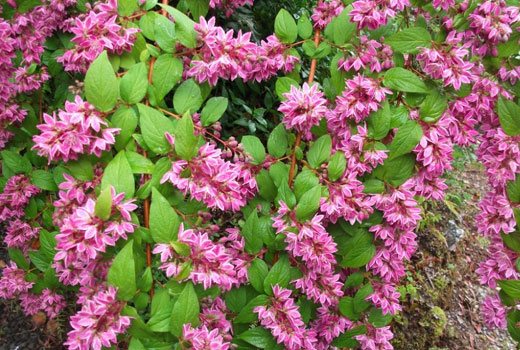

Original inflorescences of action
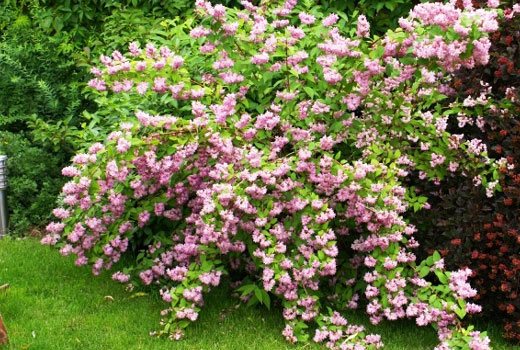

The drooping branches of the shrub demonstrate its luxuriousness.


You can choose a shrub with white flowers
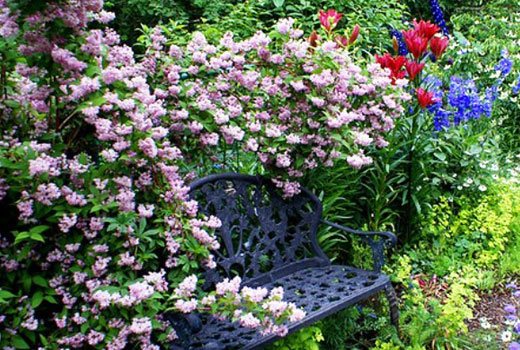

Pink flowers are airy and tender
This plant tolerates partial shade or even shade well, but at the same time, when the plant does not have enough light, the flowering will not be too abundant and lush. To achieve the greatest decorative effect of the hedge, the action must be planted in moist, loose and nutritious soil. Moreover, it must be neutral or alkaline acidic soil acts depressingly on this shrub. When planting, be sure to add lime or wood ash to the soil to ensure that the soil is low in acidity. The distance between the bushes in the hedge is about 1 m, the depth of the planting pit is about 50 cm.


Sophisticated action will decorate any garden
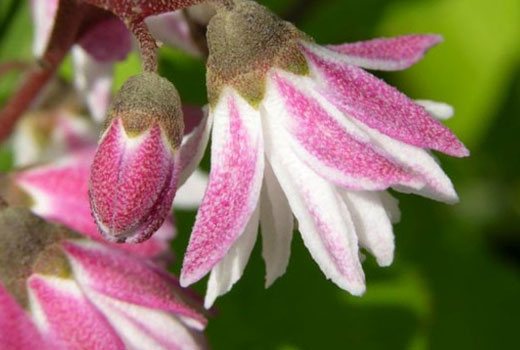

Shrub with white-pink flowers
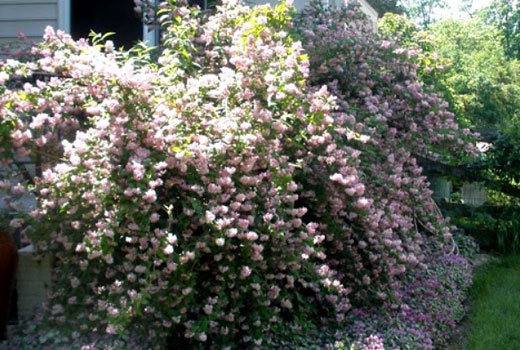

Ornamental shrub in bloom
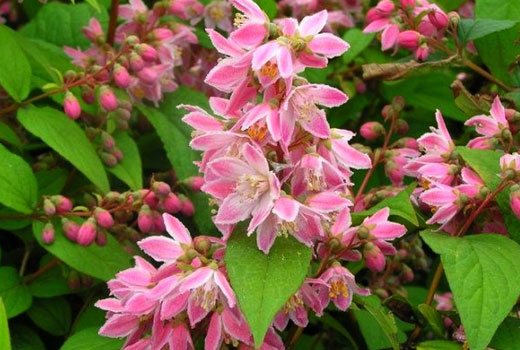

Complex action color - pink with beige
Action generally tolerates negative environmental factors well. In winter, during frosts, the shoots of the bush can be damaged, and sometimes even the bush partially freezes out. However, the ability to recover from action is high. But if winters are especially frosty in the region, the plants can be insulated by covering the bushes with film, lutrasil, etc.
Action varieties for our gardens
- Amurskaya
- Gorgeous
- Vilmorena
- Wilson
- Long-leaved
- Graceful
- Large-flowered
- Lemoine
- Rough, or star-shaped
Every ornamental shrub will be the best in your garden if it is cared for properly.
ON THIS TOPIC
The best shrubs for the garden: an overview of deciduous species, 35 photos
Yew
A distinctive feature of these evergreens is the flat, dark green needles and red small cones that look like berries. It grows for a long time, but it can easily live up to 3 thousand years.
It tolerates shade perfectly, does not like gassed air. Grows well on loose soils, tolerates drought well.
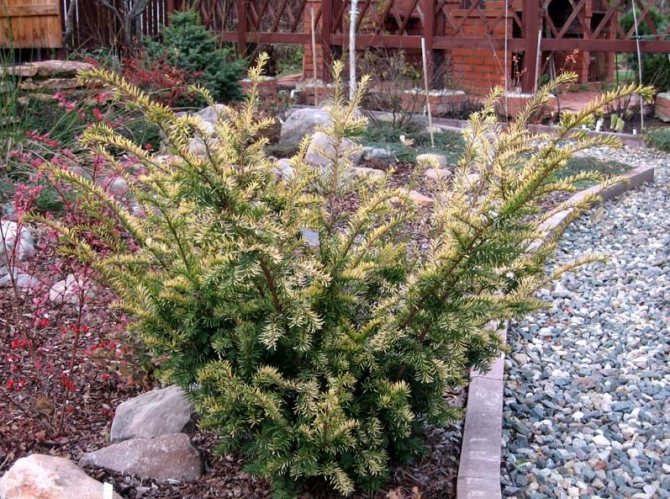

Important! Cones, needles and bark of yews contain toxic substances. In no case should they be eaten. After planting, caring for the tree, touching it, be sure to wash your hands well. It is recommended to exclude contact with the plant of children and pets.
Eight types of yew are known. The most popular is berry yew, and today a large number of its undersized decorative varieties have been bred:
- "Elegantisima" - perfect for the formation of hedges and group plantings, a ten-year-old plant reaches a height of one and a half meters, young plants are interesting with white-golden needles, which change with age to green with a yellow border;
- "Semperia" - a frost-resistant variety with bright golden needles, at the age of 10 years it grows up to only 50 cm;
- "Horizontal" - the crown of this yew grows very broadly, and reaches a height of only 1 meter, the needles are light green;
- "Washington" - has a beautiful curved green needles with a golden border.
Yew tolerates cutting and pruning well, therefore it is suitable for the formation of a decorative crown.

